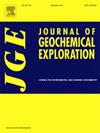Leaching behavior and mechanism of Cu and Cd in acid paddy soil under acid mine drainage
IF 3.3
2区 地球科学
Q1 GEOCHEMISTRY & GEOPHYSICS
引用次数: 0
Abstract
Heavy metal pollution seriously affects soil quality, especially in paddy soils that have been polluted for a long time by acid mine drainage (AMD). However, the underlying mechanisms of the complicated AMD flooding processes in paddy soil remain poorly understood. In this study, the leaching behaviors and speciation distribution mechanisms of Cu and Cd were investigated by batch and in-situ leaching experiments under simulated AMD irrigation conditions. The results suggested that continuous AMD flooding for 180 days caused a decrease in pH and Eh until these values stabilized, at day 84 and day 70, respectively. Between pH 4.5 and 6.5, more Cu than Cd was adsorbed which was consistent with the findings of the surface complexation model (SCM). The maximum adsorption capacities of the soil was 264.84 mg/kg towards Cu and 125.96 mg/kg towards Cd. Tessier's five-step extraction showed that most adsorbed Cd was present in exchangeable fraction (F1) and carbonate-bound fraction (F2) at different depths and time points, while Cu was mainly found in Fe/Mn-bound fraction (F3) and organic-bound fraction (F4). Correlation analysis showed that migration of Cu and Cd was most susceptible to the influence of pH, Eh, and Fe. In all assessed layers of the column, Cu was retained to a greater extent than Cd. The leaching of AMD significantly increased the mobility of soil Cd. The presented data improves our understanding of the impact of long-term exposure and leaching on the mobility of heavy metals in contaminated paddy soils and assist in developing appropriate management strategies.
酸性矿井排水条件下酸性水稻土中铜、镉的淋溶行为及机理
重金属污染严重影响土壤质量,特别是长期受到矿山酸性水污染的水稻土。然而,水稻土中复杂的AMD水淹过程的潜在机制仍然知之甚少。本研究通过模拟AMD灌溉条件下的批量和原位浸出试验,研究了Cu和Cd的浸出行为和形态分布机制。结果表明,连续180天的AMD浸水导致pH和Eh分别在第84天和第70天趋于稳定。在pH为4.5 ~ 6.5之间,Cu的吸附量大于Cd的吸附量,这与表面络合模型(SCM)的结果一致。土壤对Cu的最大吸附量为264.84 mg/kg,对Cd的最大吸附量为125.96 mg/kg。Tessier五步萃取法表明,在不同深度和时间点,吸附的Cd主要存在于交换层(F1)和碳酸盐结合层(F2)中,而Cu主要存在于Fe/ mn结合层(F3)和有机结合层(F4)中。相关性分析表明,Cu和Cd的迁移最易受pH、Eh和Fe的影响。在柱的所有评估层中,Cu的保留程度大于Cd。AMD的浸出显着增加了土壤Cd的流动性。所提供的数据提高了我们对长期暴露和浸出对污染水稻土中重金属流动性的影响的理解,并有助于制定适当的管理策略。
本文章由计算机程序翻译,如有差异,请以英文原文为准。
求助全文
约1分钟内获得全文
求助全文
来源期刊

Journal of Geochemical Exploration
地学-地球化学与地球物理
CiteScore
7.40
自引率
7.70%
发文量
148
审稿时长
8.1 months
期刊介绍:
Journal of Geochemical Exploration is mostly dedicated to publication of original studies in exploration and environmental geochemistry and related topics.
Contributions considered of prevalent interest for the journal include researches based on the application of innovative methods to:
define the genesis and the evolution of mineral deposits including transfer of elements in large-scale mineralized areas.
analyze complex systems at the boundaries between bio-geochemistry, metal transport and mineral accumulation.
evaluate effects of historical mining activities on the surface environment.
trace pollutant sources and define their fate and transport models in the near-surface and surface environments involving solid, fluid and aerial matrices.
assess and quantify natural and technogenic radioactivity in the environment.
determine geochemical anomalies and set baseline reference values using compositional data analysis, multivariate statistics and geo-spatial analysis.
assess the impacts of anthropogenic contamination on ecosystems and human health at local and regional scale to prioritize and classify risks through deterministic and stochastic approaches.
Papers dedicated to the presentation of newly developed methods in analytical geochemistry to be applied in the field or in laboratory are also within the topics of interest for the journal.
 求助内容:
求助内容: 应助结果提醒方式:
应助结果提醒方式:


